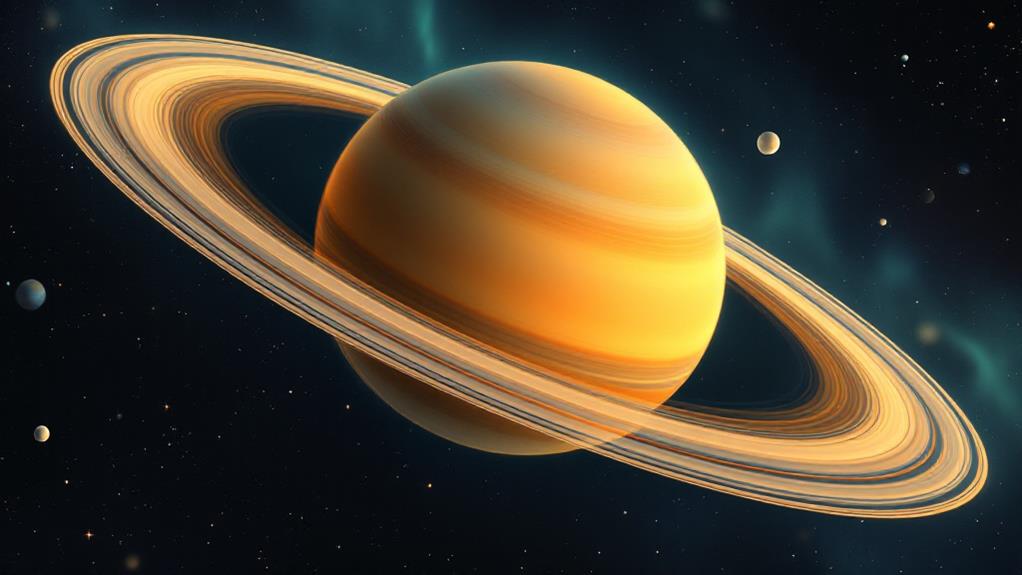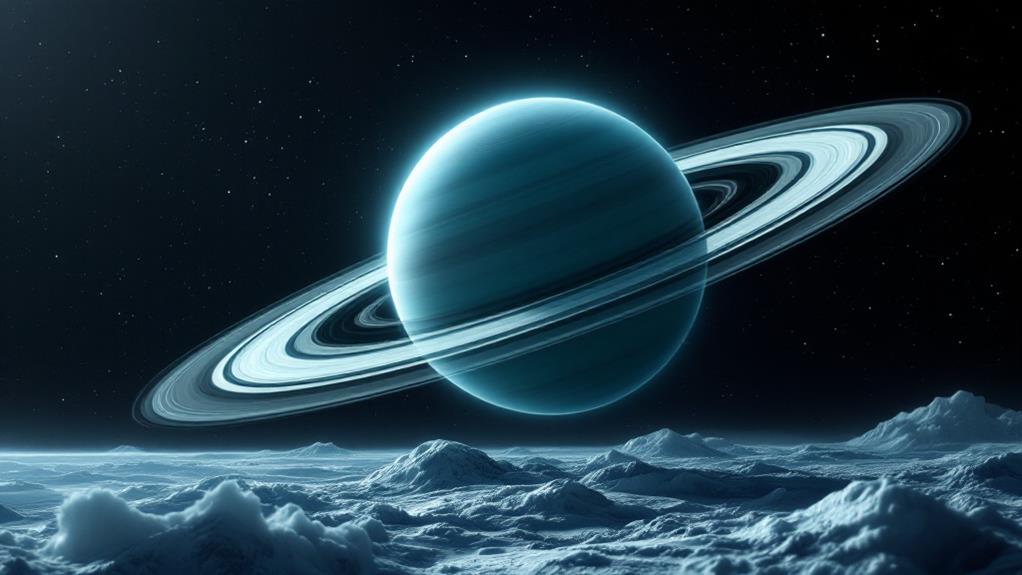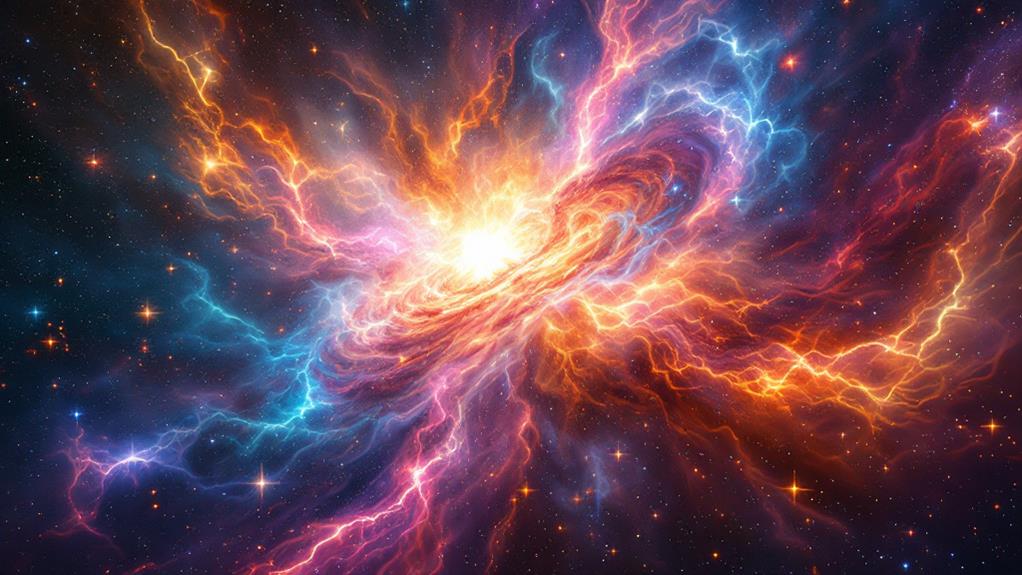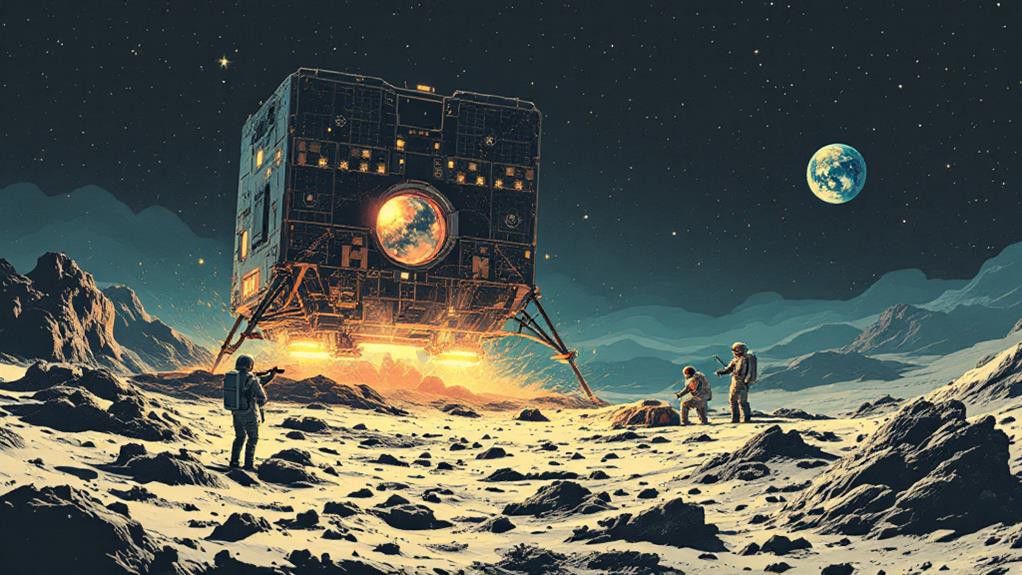Fascinating Facts About the Milky Way: Exploring Our Galactic Home
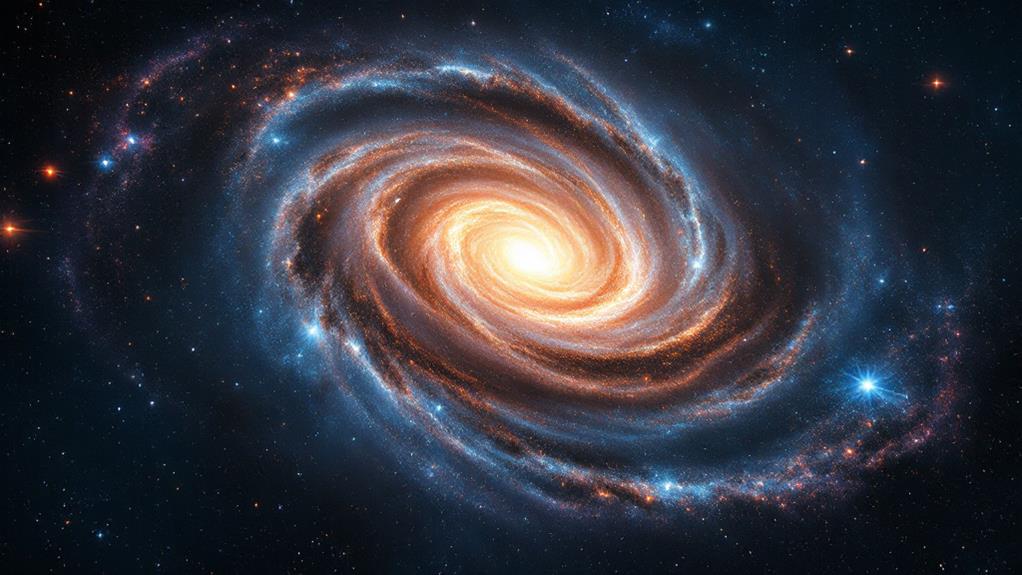
You're living in a vast cosmic metropolis that stretches 100,000 light-years across and contains up to 400 billion stars. Our Milky Way galaxy is a spiral beauty, with four major arms swirling around a supermassive black hole at its center. Dark matter makes up 85% of the galaxy's mass, shaping its structure and dynamics. The Milky Way isn't static; it's actively consuming smaller galaxies and will eventually collide with Andromeda. Interstellar dust and gas create stunning nebulae, while an invisible magnetic field influences cosmic phenomena. There's so much more to uncover about our galactic home.
Our Galaxy's Immense Size
Visualize this: our Milky Way galaxy stretches an astonishing 100,000 light-years across, containing an estimated 100-400 billion stars. That's a space so vast, it's almost impossible to comprehend. To put it in a different perspective, if you could travel at the speed of light, it'd take you 100,000 years to cross from one end to the other.
The Milky Way's mind-boggling dimensions don't stop there. Its disk is about 1,000 light-years thick, and it's surrounded by a spherical halo that extends much further. When you consider its unfathomable volume, you're looking at millions of cubic light-years of space.
But size isn't everything. Within this cosmic expanse, you'll find a diverse array of celestial objects. From giant molecular clouds where stars are born to the remnants of long-dead stars, our galaxy is a thriving hub of cosmic activity. And at its center lies a supermassive black hole, Sagittarius A*, which acts as the gravitational anchor for this entire system. It's a reminder that even in the vastness of space, there's order and structure.
Billions of Stellar Inhabitants
One might think the Milky Way's vastness would make it a lonely place, but it's teeming with stellar life. Our galaxy is home to an estimated 100-400 billion stars, each with its own unique characteristics and potential for planetary systems.
The Milky Way's stellar population diversity is astounding. You'll find everything from tiny red dwarfs, barely larger than Jupiter, to massive blue giants dozens of times the size of our Sun. Between these extremes lie stars of various sizes, temperatures, and ages, including white dwarfs, neutron stars, and even black holes - the remnants of stellar evolution.
Star formation rates in our galaxy continue to impress astronomers. While not as active as in its youth, the Milky Way still produces about one to two new stars every year. This ongoing stellar birth guarantees a constant renewal of our galactic neighborhood.
As you gaze at the night sky, remember that each visible point of light represents just a tiny fraction of the billions of stars populating our cosmic home. The Milky Way's stellar inhabitants create a rich mosaic of light, energy, and potential for life across its vast expanse.
The Galactic Center's Black Hole
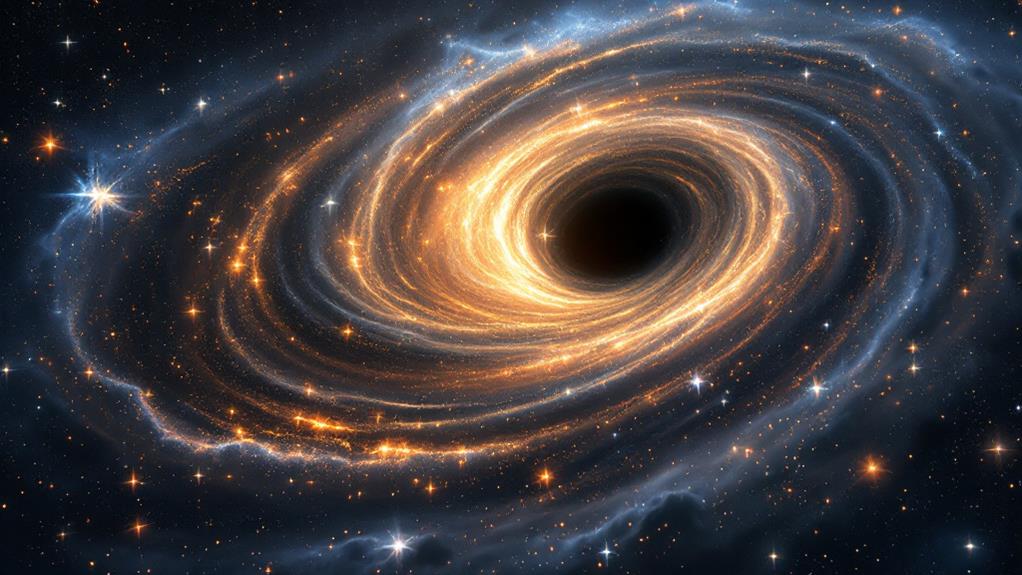
At the heart of our stellar metropolis lies a cosmic behemoth that shapes the Milky Way's very structure. This colossal entity is a supermassive black hole named Sagittarius A*, located about 26,000 light-years from Earth. With a mass equivalent to about 4 million suns, it exerts a powerful gravitational influence on the surrounding stars and gas.
You might wonder how scientists uncovered this invisible giant. They've observed the orbits of stars near the galactic center, which move at incredibly high speeds due to the black hole's immense gravitational pull. These observations have also revealed that Sagittarius A* isn't stationary; it's slowly growing by consuming nearby matter.
The supermassive black hole plays a pivotal role in galactic disk dynamics. Its gravitational force helps maintain the spiral structure of the Milky Way and influences the distribution of stars and gas throughout the galaxy. While it's not currently active, periodic flares suggest that it occasionally consumes passing clouds of gas or unfortunate stars that venture too close.
Dark Matter's Invisible Influence
Peering beyond the visible stars and gas, scientists have uncovered that the Milky Way is largely composed of an enigmatic substance called dark matter. This invisible material makes up about 85% of our galaxy's mass, yet it doesn't interact with light or other forms of electromagnetic radiation. You can't see it, touch it, or detect it directly, but its presence is inferred through its gravitational effects on visible matter.
Dark matter's unseen presence plays a fundamental role in shaping our galaxy's structure and dynamics. It forms a vast halo around the Milky Way, extending far beyond the visible disk of stars. This dark matter halo helps explain why stars in the outer regions of our galaxy orbit at speeds faster than expected based on visible mass alone.
Scientists are still working to understand the nature of dark matter. Leading theories suggest it could be composed of exotic particles that don't interact with regular matter except through gravity. While its exact composition remains a mystery, dark matter's gravitational effects continue to influence the Milky Way's evolution and the motions of stars and galaxies throughout the universe.
Milky Way's Spiral Structure
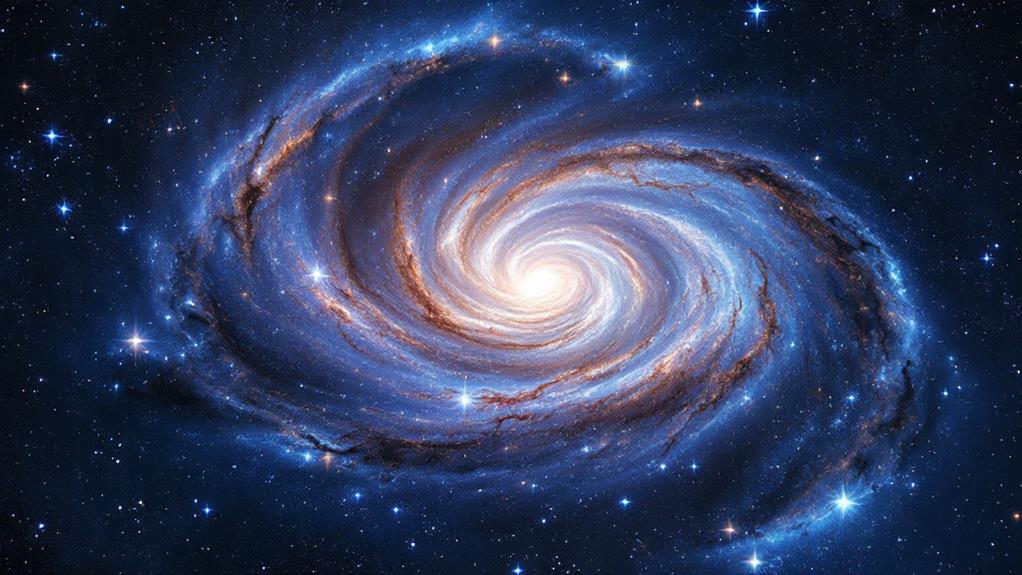
From the vantage point of an outside observer, the Milky Way's spiral structure would be a breathtaking sight. Our galaxy boasts four major galactic arms, each stretching out from the central bulge like cosmic pinwheels. These arms, named Sagittarius, Orion, Perseus, and Scutum-Centaurus, are where you'll find most of the Milky Way's star-forming regions.
As you investigate the spiral structure, you'll uncover that these arms aren't solid structures but rather areas of higher density. They're home to countless stellar nurseries, where new stars are born from vast clouds of gas and dust. The spiral shape is maintained by density waves, which compress the interstellar medium as they pass through, triggering star formation.
You might be surprised to learn that our Sun isn't located in any of the main arms. Instead, it resides in a smaller spur called the Orion Arm, about 26,000 light-years from the galactic center. This positioning provides us with a unique viewpoint on our galaxy's structure, allowing astronomers to map the Milky Way's spiral arms through careful observation and analysis.
Our Solar System's Location
Our cosmic address within the Milky Way is both humbling and awe-inspiring. You're situated in the Orion Arm, a minor spiral arm nestled between the larger Perseus and Sagittarius Arms. If you could zoom out, you'd find yourself about 26,000 light-years from the galactic center, roughly halfway between the core and the outer edge of the disk.
Our solar system's motion isn't static; you're orbiting the galaxy's center at a breakneck speed of about 220 kilometers per second. It takes around 225-250 million years to complete one galactic year, or a full orbit around the Milky Way's center.
In terms of galactic coordinates, astronomers use a system similar to Earth's latitude and longitude. Your position is often described using galactic longitude and latitude, with the galactic center serving as the reference point. This helps pinpoint our location relative to other celestial objects within the Milky Way.
Understanding your place in the galaxy provides outlook on the vastness of space and the intricate dance of celestial bodies that surrounds you.
Galactic Cannibalism in Action
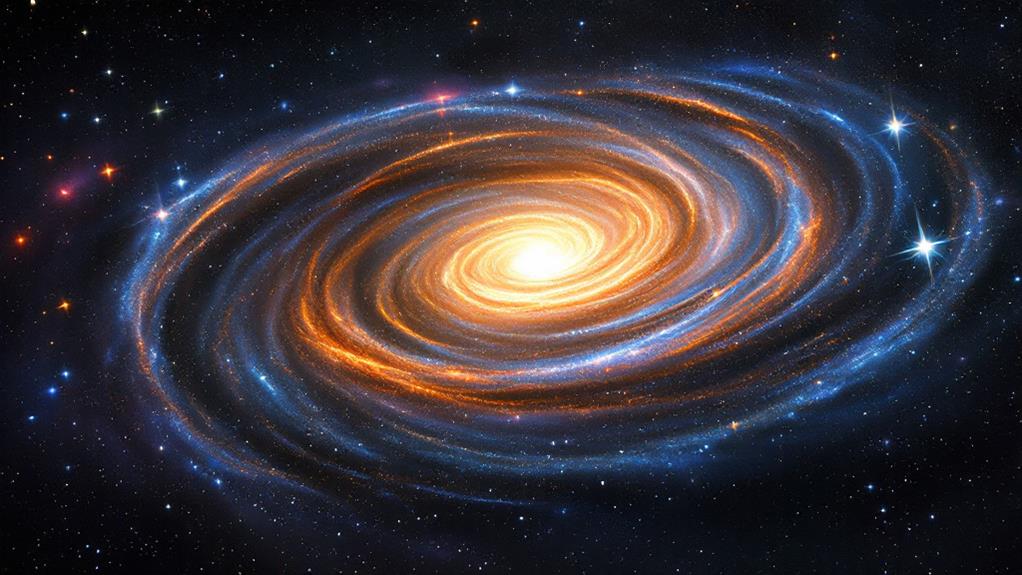
The Milky Way isn't just growing old; it's actively devouring its neighbors. This process, known as galactic cannibalism, is an essential part of our galaxy's evolution. You might think of the Milky Way as a cosmic predator, constantly on the hunt for smaller galaxies to consume.
As the Milky Way's immense gravitational pull attracts nearby dwarf galaxies, it tears them apart and absorbs their stars. This ongoing feast has shaped our galaxy's structure and composition over billions of years. The Sagittarius Dwarf Spheroidal Galaxy is a prime example of this process in action. It's currently being stretched and pulled apart by the Milky Way's galactic tides.
During these galactic mergers, stellar collisions can occur, creating new stars and reshaping existing star clusters. The debris from these cosmic encounters often forms long streams of stars, which astronomers can observe as evidence of past and ongoing galactic cannibalism.
You're living in a transformative galaxy that's constantly growing and changing. The Milky Way's cannibalistic behavior isn't just a fascinating phenomenon; it's a fundamental aspect of galactic evolution throughout the universe.
Interstellar Dust and Gas
Between the stars of our Milky Way lies a vast, often overlooked component: interstellar dust and gas. This cosmic haze plays an essential role in the galaxy's evolution and star formation processes. Interstellar dust composition varies, but it typically includes tiny particles of carbon, silicates, and ice. These microscopic grains absorb and scatter starlight, shaping the appearance of our galaxy.
Interstellar gas dynamics are equally fascinating, with hydrogen and helium making up the majority of this diffuse material. This gas serves as the raw material for new stars and planets, constantly recycling through stellar lifecycles.
To better understand the significance of interstellar dust and gas, consider these key points:
- They act as cosmic nurseries, providing the building blocks for new stars and planetary systems
- They influence the galaxy's overall structure and appearance by obscuring certain regions
- They serve as catalysts for complex chemical reactions, potentially contributing to the formation of organic molecules
You'll find interstellar dust and gas concentrated in the spiral arms of the Milky Way, where they create stunning nebulae visible through telescopes. These cosmic clouds continue to captivate astronomers, offering deep comprehension into our galaxy's past, present, and future.
Milky Way's Magnetic Field
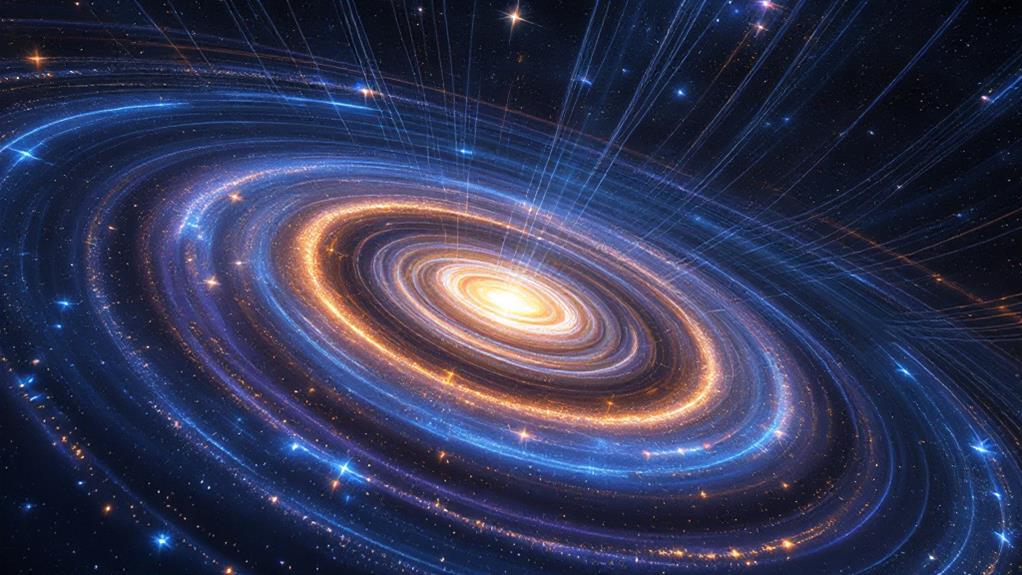
Invisible yet influential, the Milky Way's magnetic field stretches across our galaxy, shaping cosmic phenomena on a grand scale. You might not see it, but this magnetic force plays an essential role in various galactic processes.
The magnetic field's structure is complex, with both large-scale and small-scale components. It's believed to originate from a galactic dynamo mechanism, where the rotation of the galaxy and turbulent motions of ionized gas generate and maintain the field. This process is similar to Earth's magnetic field but on a much grander scale.
You'll find the magnetic field affects everything from star formation to the movement of cosmic rays. It helps regulate the flow of gas in the galactic disk and influences the formation of spiral arms. The field also plays a role in shaping supernova remnants and guiding the paths of high-energy particles.
Scientists study the Milky Way's magnetic field using various techniques, including radio astronomy and polarization measurements. Understanding this invisible force helps us uncover the mysteries of our galaxy's evolution and structure.
Future Collision With Andromeda
Buckle up for a cosmic collision! Our Milky Way is on a collision course with the Andromeda galaxy, and it's an event that'll reshape our cosmic neighborhood. This galaxy's future collision is set to occur in about 4.5 billion years, so there's no need to panic just yet.
The Andromeda collision timeline is a fascinating glimpse into our galaxy's distant future. As the two massive spiral galaxies approach each other, their gravitational forces will begin to interact, causing dramatic changes in their structures. Here's what you can expect:
- The galaxies will dance around each other, distorting their shapes
- Stars from both galaxies will be flung into new orbits
- A new, larger elliptical galaxy will form from the merger
You might wonder about Earth's fate during this cosmic crash. Don't worry – the vast distances between stars mean that direct collisions are unlikely. However, Earth may be moved to a different position within the new galaxy. This galactic merger will create a spectacular light show for any future observers, as new star formation is triggered by the collision of gas clouds.
